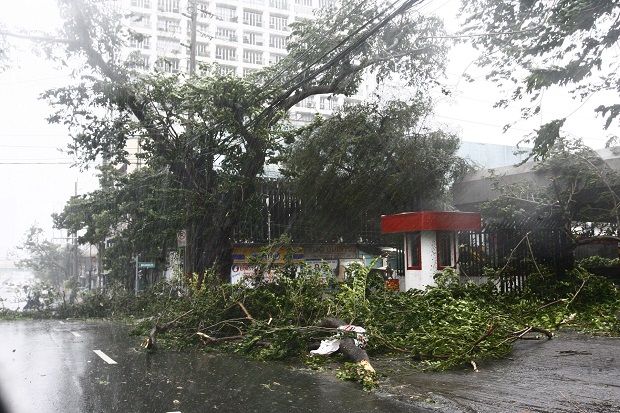
Fallen trees along España in Manila after the strong winds brought by Typhoon Glenda. INQUIRER PHOTO/ JOAN BONDOC
MANILA, Philippines–Even with three of the affected regions still to submit damage reports, the Department of Education (DepEd) has already started a rapid damage assessment of more than 25,000 schools affected by Typhoon Glenda (international name: Rammasun) that would need a “quick fix.”
A total of 115 school divisions in 12 regions were affected by the typhoon’s destructive path across the country, Education Secretary Armin Luistro told a press conference on Thursday.
“Although Typhoon Glenda had a large diameter, based on our initial reports it was not as devastating as Yolanda. One good news is that 54 school divisions, or 47 percent of those 115 divisions, have resumed classes. So, compared to Yolanda where there was cancellation of classes for one or two weeks, at least here classes resumed after a day or two,” he said.
No report yet
However, the DepEd is faced with the problem of school divisions that have not yet reported to the department.
“We cannot get in touch with the schools. Most of them still have no power so they cannot charge their phones and submit reports. We cannot also call them. But in general, we have reached most of our divisions and we are pleased that nearly half of those 115 divisions have resumed classes,” Luistro said.
Most of the divisions which have not reported to the DepEd are in Calabarzon, Mimaropa and the Bicol Region, the very schools that may have sustained major damage, Luistro said.
In a rapid damage assessment, Luistro explained, the DepEd compiles data obtained directly from the school principals on the extent of the damage sustained or the condition of the schools as well as their immediate requirements.
Evacuation centers
According to DepEd Assistant Secretary Reynaldo Laguda, the 115 school divisions are part of the total 162 divisions in the 12 Glenda-affected regions, including the National Capital Region (NCR). He explained that each province or component city has a school division, which is the DepEd’s basic unit of organization.
Laguda said that there were 25,856 schools that were affected by the typhoon, either declaring a suspension of classes, or sustaining damage, or under typhoon signals. Of this number, 187 are being used as temporary evacuation centers.
The rapid damage assessment, he said, is basically a quick accounting from all the school divisions affected by the typhoon on how many classrooms have been completely or partially damaged and how many can be repaired at the school level. He said the use of the schools as evacuation centers will also be factored into the assessment.
Laguda asked the public, particularly netizens, to help by reporting any damaged schools they see via Twitter and the DepEd’s official e-mail. “We would like to get the public to join in. This really helps us in trying to bridge the information gaps and allow us to make better and realistic decisions,” he said.
Luistro said that the agency’s P650-million quick-response fund is available to help the damaged schools. He said that initially the department would build makeshift classrooms and make quick repairs.
Lesson from ‘Yolanda’
The secretary said that the DepEd has received some flak for this “quick fix” plan. But this was a lesson learned from Super Typhoon Yolanda, he said.
“The DepEd’s target really is to have classes resume as soon as possible. The department’s plan is to build makeshift classrooms so that classes can be held there while permanent classrooms are being built,” he said.
Citing the massive effect of Glenda involving more than 25,000 schools, Luistro also asked the school principals if they could shoulder the expenses for minor repairs.
“If the damage is extremely minimal, the repair of which can easily be financed by the barangay (village) or even the PTA (Parent-Teacher Association), the quick-response fund need not be tapped for that,” he said, referring to schools that have already resumed classes.